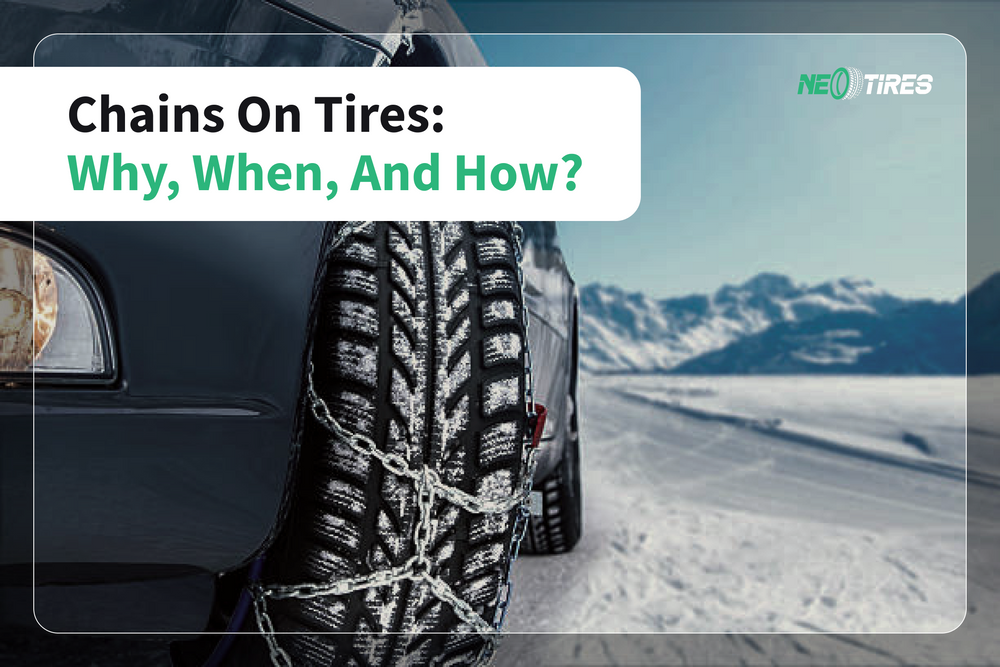People who live in areas that are not exactly weather-friendly know what a great idea a set of tire chains is for their cars. These are tools that help a car provide better traction when the snow takes full control. They are sometimes helpful even in circumstances without snow or ice.
It is about mountainous roads full of rocky challenges with high inclination angles. Drivers who are always in such circumstances must always have chains in their car, for "just in case" scenarios. Let's see more details about this topic that seems not very important at first glance, but which, however, might be helpful in a critical moment.
What Are Tire Chains?
Many drivers call these "tools" either tire chains or snow chains (although they can be used not necessarily in snowy conditions). Regardless of the name you prefer, these are tools that the driver attaches to the tires. They add complexity to the tread of the tire so that it can face more difficult roads. Drivers can choose different types of chains. They differ in their design, but all share the same purpose.
How Do Tire Chains Work?
The chains are tightly attached to the car's tires. They are fixed as tightly as possible so that they do not change their position very much while driving. Once the car starts on a snowy road, these chains do not allow the car to skid as it would normally, without chains. Respectively, the purpose of the chains is to add traction to the car on the road.
Once the traction increases, the probability that the car will slide is much lower, allowing the driver to face very difficult and icy or snowy roads. These chains are made of iron, steel, or any other highly durable metal, so they are extremely resistant both to ice and snow, as well as to the massive weight of the car body. Depending on the frequency of their use, they can serve up to several years.
Are Tire Chains Necessary?
The use of chains is an allowed norm only in some US states. As you can see, it is about mountainous areas, where snow and ice are frequent aspects of everyday life. However, most areas do not regulate this aspect by law and leave the use of chains exclusively at the discretion of the driver. So each driver decides for himself how much a set of chains is necessary for him, depending on the conditions in which he drives most often.
A good number of drivers opt for a set of chains only because they are extremely cheap compared to performant winter tires to withstand stormy weather. Another part of drivers put a set of chains in the trunk for "just in case" scenarios, considering their benefits. Let's see what some of them are.
Tire Chain Advantages
Efficient Traction
No type of tire can offer the same traction as those on which a set of chains are mounted. The vehicle becomes much more stable and safe on dangerous and slippery roads thanks to the increased traction it offers. Their most relevant argument consists in their effectiveness, which for now cannot be offered by any other alternative. In the same context of advantages, they are extremely cost-friendly and adaptable to any conditions.
Versatility
Drivers usually associate tire chains only with icy and snowy conditions. But in fact, they save a lot in mountainous road conditions where large stones and inclined angles present obstacles that are difficult to overcome.
Confident Deep Snow Performance
Tires with chains on them cope perfectly with areas with deep snow. it is unlikely that the car will remain stuck on a deep snow road because the traction is superb thanks to them.
Easy Handling
Attaching chains does not require knowledge of quantum physics. Any driver can fix them to the tires. They do not require complicated maintenance, it is only necessary to avoid keeping them in humidity to prevent them from rusting.
How To Attach Chains To Your Tires
Some drivers think that the process is quite complex. But the truth is that attaching them is quite easy if you take into account the following steps.
#1#
First of all, you have to keep in mind that you cannot attach the chains as you like. You have to consider the type of traction of your car. The logic is very simple: vehicles with front-wheel drive will wear chains on the front wheels. Similarly, rear-wheel drive vehicles will have chains on their respective wheels.
Many drivers ask what the formula is for FWD cars. The specialists claim that it is enough to attach chains only to the front tires. With such a car, you need to improve the steering traction. So, attaching chains to the front wheels solves this task perfectly and there is no need to mount chains on all 4 wheels.
#2#
To install chains on tires, it is necessary to find a comfortable parking place. A garage or any space without snow will perfectly do. All you have to do is wrap the chains over your tires and tuck a chain end under the tire front.
The next step is to connect the ends of the chains. So after tire wrapping, take the 2 free ends and form a loop encircling the tire by connecting them. Try to make the connection as tightly as possible.
#3#
After connecting, it is necessary to check the connection of the chains and adjust them if necessary. For this, you will have to start the car and slowly drive a few meters. Try to turn the steering wheel slightly. In these circumstances, the chains will settle in, letting you know if they are sufficiently tight or loose. If they lose their tightness, adjust them by connecting them even tighter.
#4#
Attach the chains only when strictly necessary. In optimal road conditions, there is absolutely no point in wearing them. You can lose control of the car and damage your tires.
Bottom Line
The idea of having a set of chains is a good one, especially for areas where snow and ice are common weather conditions. Their attachment makes your driving experience easier and offers an increased degree of safety.
Tire Chains: FAQs
Are Tire Chains a Good Idea?
Tire chains are a great idea when you need superior traction in highly challenging road conditions. This can refer to severe snow, mud, or rocky conditions. However, mounting chains comes with several precautions. For example, you should never use them on smooth roads where there is no ice or snow. Also, driving at high speed with chains on is not at all safe. So, these are a great option when you need safe and reliable traction and you know that tires can't do it alone.
At What Point Do You Put Chains On Tires?
First of all, drivers cannot install chains when and where they want. Chain use is regulated by the state, which allows them in certain weather and road conditions. As such, you must, first of all, make sure that the state in which you live allows the use of chains. In most cases, they are used in northern geographic areas where snow and ice make it difficult for tires to cope with them alone.
Do You Put Snow Chains On All 4 Tires?
That depends on several aspects. If we refer to the legal aspect, then no - you must not mount chains on all 4 tires. It is enough that at least one of the axles has chains, either front or rear. If we refer to the safety aspect, the drivers themselves decide how to use them depending on the road conditions. A single set is usually enough to add some significant traction. But if the road conditions are too severe, you can go with 2 sets for both axles.
Do Tire Chains Damage Tires?
If you use them in the correct conditions and take into account the manufacturers' recommendations, then chains are unlikely to damage your tires. These recommendations refer to:
- maintaining low speed when with chains on
- using chains only in allowed conditions such as harsh snow and ice
- driving carefully on potholes
- not using them on paved, clean, smooth roads because they severely damage them.
Do Chains Work On Ice?
Sure thing. Chains are not just for snowy conditions. They do great work on ice, rocks, and mud as well. These cut through ice ensuring superb traction.
What Is The Maximum Speed With Snow Chains?
When you decide to put chains on tires, you have to change your driving style. First of all, the speed limit is no more than 30mph. The speed limit is necessary to prevent chain breaking which could severely affect the tire and the area around it. Second, you have to be very careful about potholes. Hitting a pothole with chains on can damage the condition of the tires, transmission, and suspension depending on impact severity.
Why Trust Us?
The wrong tires can severely worsen the driving experience and put your safety at risk. That's why, choosing the right tire for your specific conditions and driving style is really important. We are here to help you in this regard.
First of all, Neotires offers a wide selection of tires for any conditions, needs, and vehicles. All are produced by reputable brands, with validated quality, and available at optimal prices.
Secondly, our qualified team helps you match your personal needs with the most suitable tires for the purpose. For this, we have mechanics, testers, and professional specialists who have been active in this industry for over 10 years.
Thirdly, we are here to offer an informational hub validated by experts who teach you about best driving tips, objective tire reviews, car maintenance practices, and much more to improve your driving experience.
Let us offer you our professional help and assistance for any tire-related questions. We are glad to share all we know so that you can have a safe, confident, efficient, and comfortable driving. Drive safe and choose your tires wisely!





